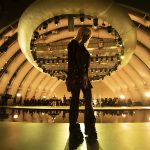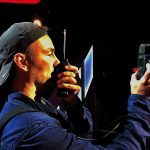For this year’s Grammy Awards, held on Feb. 15, the National Academy of Recording Arts and Sciences asked Lady Gaga to perform a tribute to the late music legend David Bowie, who died Jan. 10 at age 69. Gaga, her creative team at Haus of Gaga, along with creative collaborators at Prettybird and Studio XO, merged music and technology for a performance that evoked Bowie’s defining talent as both a visual artist and musician.
“It was an interesting process to figure it all out; as a tribute to David it was important that it be an emotional, celebrative experience of his life and art,” says production designer LeRoy Bennett, principal at Seven Design Works. Bennett, who has worked with both Bowie and Lady Gaga previously, enjoys when artists stretch the production elements to experiment with new technologies.
High Tech and Creative
For the Grammy performance, Haus of Gaga worked closely with Intel as a true creative collaborator, explains Bennett. “It was two worlds kind of coming together; two purposes coming together. It was an interesting collaboration; Intel, with their whole team, software people, all the creative team, the interactive technology people, the content team. The content was directed by creative director Ruth Hogben; she does most all of Gaga’s visual stuff. It was an exciting collaboration to be a part of for a live performance.”
Along with Intel, Gaga also teamed with digital artist Nobumichi Asai of WOW, Inc. He created the 3D video mapping effect that overlaid Bowie-inspired graphics on Lady Gaga’s face as the six-minute tribute began. A key challenge was to make this digitally mapped close-up projection work while Lady Gaga was singing. After taking a 3D scan of her face, the team then created 3D printed models of different expressions so they could rehearse and perfect the technology. This was the first time Asai presented the face mapping live. The rehearsals and meticulous planning were evident during the show.
“For me, the face mapping technology was probably the most fascinating in fitting this all together, just because suddenly she became some of the most outstanding characters of David’s career,” Bennett comments. “I felt it was pretty amazing to watch that technology work. Particularly in what is really an uncontrolled environment. You’re bringing all that technology into a situation where you’re just a small part of a big show. It’s not something that’s permanently sitting there. We brought much of it in during the set change. Some things like the smoke machines and projectors were in position prior to the set change; but having to set up this face mapping—the projector, the small camera in the center, and everything; it was quite complex.”
The interactivity of image tracking with the use of Intel’s tiny wearable Curie technology was another key element that the creative team took advantage of for visual impact. The Curie chip, which brings micro-computing to the size of a button, was built into the rings that Lady Gaga wore and a band at the end of Nile Rodgers’ guitar. This wearable device tracked their movements to be translated for image tracking of the video projections.
3D Positioning via Wearable Chips
The 3D positions as well as a range of pre-defined gestures of the performers wearing the Curie rings were captured in real-time and produced graphics using the real-time plug-in Notch, a visual engine. Notch allowed for image mapping and playback by d3 Technologies’ d3 servers, which also triggered the robotic keyboard.
Troy Fujimura from d3 Technologies handled technical management along with David Bajt of BAJT, who programmed and operated the show. Others who worked closely with Fujimura and Bajt on the planning and engineering of the d3 media server system included d3 systems engineer Stephan Hambsch from VER and Joss Gray of Joss Gray Limited, who dealt with the Intel Curie and d3 integration. Gray wrote custom tracking code for d3 to work hand in hand with the Curie technology. The video equipment was supplied by VER and content creation was handled by Chris Pearson and Chris Davenport.
Show tech producer Mark Logue was an essential pivot point for all of the technology merging into the creative of the performance. Along with the Intel Curie technology and the facial mapping, the performance was further enhanced with “holographic” 3D visuals created by projection on to a 20-by-5-meter Holo-Gauze screen, a highly transparent and highly reflective gauze material. Matched with the Curie technology, the colorful 3D “smoke” projections on the Holo-Gauze seemed to emanate from the rings on Gaga’s hands and the Curie band on Rodgers’ guitar, concluding with Bowie’s face emerging out of the smoke.
With so much interactive technology and integration of different systems involved in the performance, rehearsal and time to work through all the components in a full system setup was crucial. Intel and the creative teams took up a month-long residence in a sound stage at Universal to set all of the various systems up, integrate them together, and resolve any issues. They matched the size and layout of the Grammy Awards stage to get as close as possible to show conditions.
For the performance’s lighting design, Bennett used much of the lighting rig that Grammy lighting designers Robert Dickinson and Jon Kusner from Full Flood, Inc. had put in place for the evening.
“We did use quite a bit of their lighting rig,” explains Bennett. “We duplicated the lighting system in rehearsals at Universal. Because we had all of these [Intel] Curie sensors and other technologies; we wanted to make sure that if there was any RF or other interference with these sensors, we’d discover it then, before getting into The Grammys. We didn’t want any surprises and find out that something wouldn’t work at the last minute.”
Bennett found it a very interesting experience implementing that much technology into a single performance on a live awards show. “It was very ambitious,” he notes. “I enjoyed working with the Grammys’ team and the Gaga world, as well as the Intel people. It was a very creative, very focused, and very interesting project to be involved with, especially having worked with David. It meant a lot to do this tribute on the Grammys. Plus I absolutely adore Gaga, and I have a lot of respect for her and her process. She’s a true artist and she has a great understanding of what it takes to be an artist. She is very much like Bowie in that way.”


